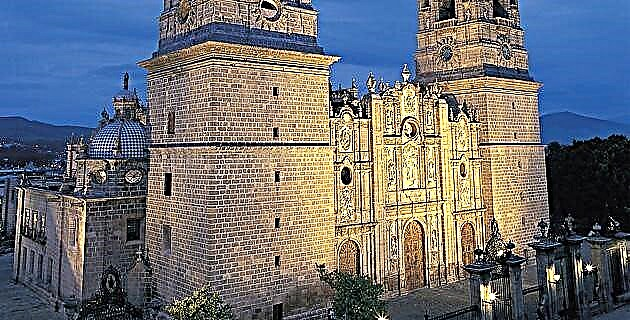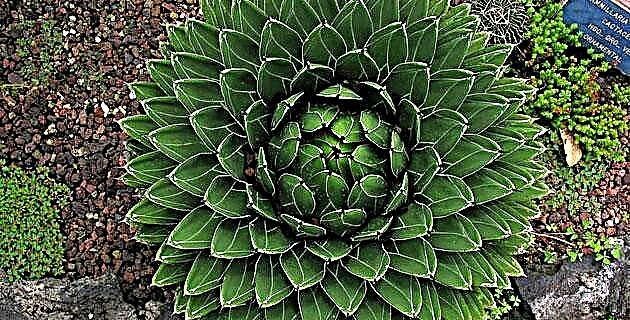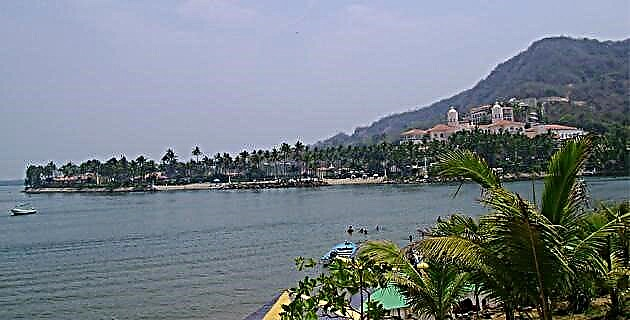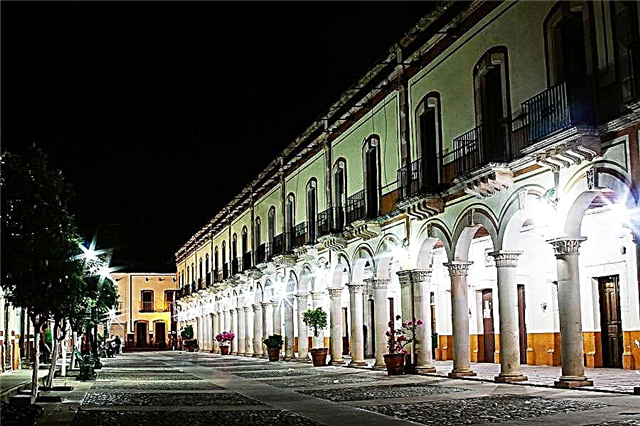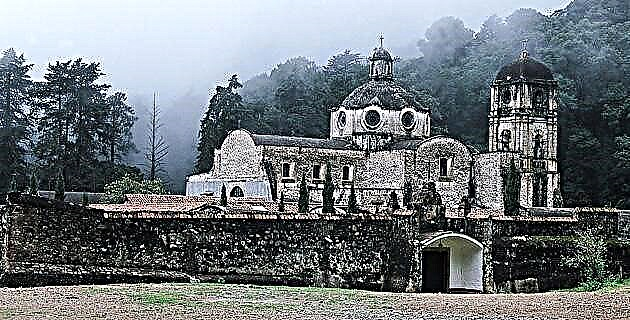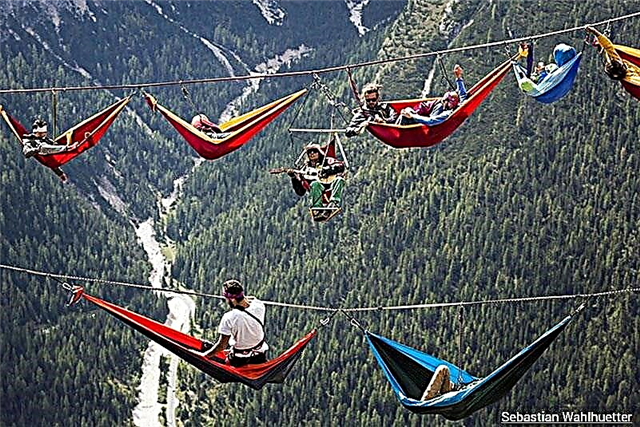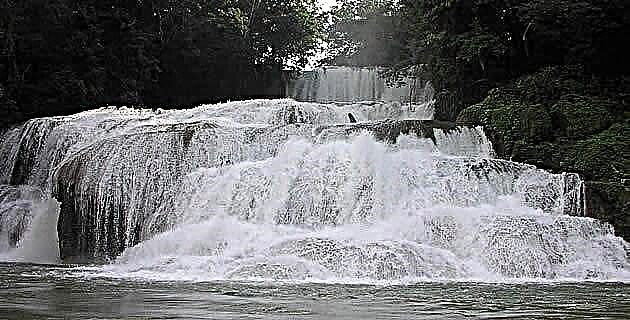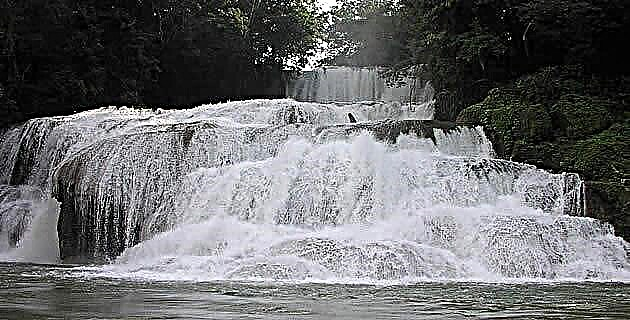
When we arrived at the mouth of the Busilhá, a tributary of the Usumacinta River, we could not believe what we saw: a magnificent and splendid waterfall, whose song is an ode to nature.
The Lacandon Jungle, located in the southeast of Mexico, in the state of Chiapas, is considered one of the last strongholds of humid tropical forests in North America. Due to its natural characteristics, it plays an important role as a regulator of climate and rainfall; The vegetation of the Lacandon Jungle is of the type called high evergreen and sub-evergreen rainforest, the climate is an average annual 22 ° C and the rains exceed 2,500 cm3 per year; in its vast territory one of the main rivers of our country finds its course, called “Padre Usumacinta” by the locals.
To get an idea of its biodiversity, it is enough to mention that there are more than 15 thousand species of nocturnal butterflies, 65 subspecies of fish, 84 species of reptiles, 300 of birds and 163 of mammals, in addition, amphibians are represented by 2 orders and 6 families.
There are many activities that are carried out in the Lacandon Jungle: from productive to extractive, through agricultural, conservation and tourism activities; In the latter case, the Lacandona -as it is informally known- has great potential that, properly directed, can be decisive in the conservation of the area, in addition to representing an alternative of economic income for the local inhabitants.
Ecotourism - understood as a responsible practice, directed mainly to undisturbed or undisturbed areas - would thus be one of the best instruments to promote sustainable development with local economic benefits and conservation of Lacandona.
In order to get to know one of the wonders of this corner of Mexico, we decided to take a tour of the jungle, which began in Palenque, one of the main Mayan cities of the classical period that, along with Bonampak, Toniná and Yaxchilán, constitute the most important Mayan enclaves in this region - without diminishing the importance of others where there are also remains of a civilization that, at the time, found no borders and spread throughout much of Central America.
The objective of the expedition was to get to know one of the rivers found in the intricate hydrological network of the Lacandon Jungle, called in Mayabusilháo “pitcher of water”. We take the road that goes from Palenque to the jungle along the southern border highway; at kilometer 87 is the community of Nueva Esperanza Progresista, endowment of small properties to which the final part of the river belongs.
Our first contact was the operator of a minibus on the Nueva Esperanza Progresista-Palenque route. (He leaves the community at 6:00 a.m. and returns at 2:00 p.m., so if you want to take that route you have to be in Palenque at 11:00 a.m.) The road is perfectly paved until kilometer 87 where you take a dirt gap of 3 kilometers to the center of the town. It was here that the journey and our learning of the recent past of the jungle really began, thanks to Don Aquiles Ramírez who, in the company of his son, led us through the different trails.
The first part of the journey to the Busilhá river can be done on foot or by truck through a gap in good condition, the vehicle can carry the equipment with which the descent from the Usumacinta river is made until reaching the state of Tabasco; here this river loses its course and ends in floodable areas, which represents an unparalleled adventure in both calm and turbulent waters. We passed by small properties or ranches whose main activities are agriculture and livestock, and we realized without much effort that there is very little natural vegetation: we only saw pastures and cornfields.
The second part of the section is 7.3 km from the community to the mouth of the river. Now the transformed vegetation is intermingled with the natural one of the region, and as we approach our destination we find other natural elements, such as plants, large trees, birds and other animals. Another way to get there is from Frontera Corozal, a town of Chol origin located 170 km from Palenque to the east. From here it is possible to go down the Usumacinta River and reach the mouth of the Busilhá.
The Busilhá River is born at the confluence of the Lacantún River -which comes from the southern part of the Lacandona Forest- with the Pasión and Salinas rivers -which originate in the northwest region of Guatemala-. Its channel extends for just over 80 km from the Lacandón plateau, in the area called El Desempeño, it runs through several communities until it reaches its end and pays tribute to the Usumacinta, as well as other rivers of this intricate hydrological network. .
A tour of the northern region of the jungle gives an account of its recent history: large lands open to livestock and agriculture, which is based on the sowing of the ubiquitous corn (Zea mays) and chili (Capsicum annum). But between these and the banks of the rivers we find vegetation characteristic of the area, such as red cedar (Cedrela odorata), mahogany (Swietenia macrophilla), jovillo (Astronium graveolens) among vines (Monstera sp.) And a variety of palms .
Birds fly over us in search of food or a place to go; the toucan (Ramphastus sulfuratus), pigeons and parakeets are typical; while we watched them we could hear the cries of the howler monkeys (Alouatta pigra) and enjoy the spectacle produced by the otters (Lontra ngicaudis) when they swim in the river. In the region there are also raccoons, armadillos and other animals that are more difficult to observe due to their habits.
The residents of the Esperanza Progresista neighborhood have, as its name indicates, the hope of carrying out ecotourism activities. It is a community of small owners that originated 22 years ago with people who came from Macuspana (Tabasco), Palenque and Pichucalco (Chipas). Our guide, Don Aquiles Ramírez, 60 years old, founder of this colony and with great experience in the jungle, tells us: “I came to the jungle 37 years ago, I left my place of origin because there was no longer any land to We work and the owners who owned them kept us like pigeonholed laborers. "
With the closure of timber extraction by the companies, which were located in the main rivers of the Lacandon Jungle (Jataté, Usumacinta, Chocolhá, Busilhá, Perlas, etc.), many small communities were isolated in the jungle. With the opening of roads for oil extraction, large areas of land were colonized by people who came from the north and center of the state of Chiapas. Many groups have received their agrarian resolutions with endowments that overlap the decrees of the Lacandona Community and the Montes Azules Reserve itself.
With the endowment of land and the formation of the Lacandon Community between 1972 and 1976, many small communities were relocated in the so-called New Population Centers, which did not have a fully accepted emergence by the inhabitants of the region.
Between the pressures of the logging companies and the regional social struggles, in 1975 a fire broke out that spread over more than 50 thousand hectares and lasted several months; Natural resources in the northern portion of the jungle were depleted and a good part of the affected area was converted into pasture and agricultural land.
After many years, the road finally came; with it, transportation and numerous visitors interested in appreciating natural jungle places in one of the Mexican regions with the greatest biological and cultural diversity.
One of the advantages of paved or asphalt roads is that they facilitate the knowledge of many natural, archaeological and cultural sites that were previously closed due to lack of access, but the disadvantage is that they are not observed carefully enough or fully enjoyed. In addition, the ecological impacts produced by the roads and poorly planned tourism deteriorate the natural and cultural riches that coexist in these places, and run the risk of being lost forever.
Between talks with Don Aquiles and his son, we went deeper into the jungle until we reached our destination. Meandering from far away we appreciate the river that came and continued on its way; we reached its mouth and, like a curtain of rolling pearls, he seemed to pay a heavy price for his daring in facing a colossus. The Busilhá river surrenders when it meets the Usumacinta, no less than in its descent.
Due to the difference in altitude, the mouth of the Busilhá forms an impressive waterfall. There it was, magnificent and splendid, with a first drop of seven meters in height and later forming different levels as if to stagger its tribute.
After admiring it and enjoying unforgettable minutes of meditation and appreciation of the environment, we decided to swim in its waters and explore it. Helped by a rope we descended between the rocks that lie next to the first jump and in the pool that is formed we were able to submerge ourselves in the water. The levels that follow invited us to try to follow their course, although we considered that only the second step allowed us to jump without risk.
When the Usumacinta river rises in the rainy season, the lower levels of the waterfall are covered and only two plants remain; but not with this is the beauty of the waterfall less. Taking a raft tour through this section of the Usumacinta is impressive and a unique opportunity to get in touch with nature.
Thus ends this experience in the Lacandon Jungle. The more we walk it, the more we realize how little we know it.

